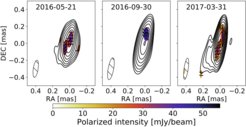Research Highlights
Here we show recent research results from the Radio Astronomy/Very-Long-Baseline Interferometry department.
Twin, but asymmetric jets in the radio galaxy NGC 1052
26 February 2019
A study of twenty-nine observations using very-long-baseline interferometry in the radio galaxy NGC 1052, led by the MPIfR PhD student Anne-Kathrin Baczko, has revealed new details of the nature of the twin jet in this object. Interestingly, the approaching (eastern) jet has higher kinetic energy, whereas the receding (western) jet has a larger internal energy or magnetic flux. The inner structure of the jet can be explained by a spine-sheath with a fast inner layer and a slower outer layer. These results are published in the present issue of the Astronomy & Astrophysics journal, for the original publication, see here.
Resolving the innermost region of the radio galaxy NGC 1275 with mm-VLBI
19 February 2019
Using the Global mm-VLBI Array, an international team of astronomers led by J.Y. Kim from the MPI für Radioastronomie, has analysed the inner polarised structure of the nearby radio galaxy 3C 84 (NGC 1257), reaching resolutions of 50 μas (corresponding to ∼200 schwarzschild radii). The results suggest that the emission is associated with an underlying limb-brightened jet. The images match in resolution the ones obtained with space VLBI in our group, several months ago (see below). These results are published in the present issue of the journal Astronomy & Astrophysics, for the original publication, see here.
Helical magnetic fields and a recollimation shock in the classical quasar CTA 102

12 February 2019
The popular radio source CTA 102 (see the song by the Californian band The Byrds from 1967) continues being the object of study of radio astronomers. A new publication apppeared today, led by the MPIfR astronomer Carolina Casadio, reports on the magnetic field configuration and the interaction between traveling shocks and a recollimation shock in its relativistic jet. The study is based on observations at the wavelengths of 3.5 mm and 7 mm performed in the mid 2010s. A Faraday rotation analysis shows a gradient in the jet and intrinsic electric vector position angles oriented around the centroid of the innermost jet feature (core), suggesting the presence of large-scale helical magnetic fields. Monitoring shows a feature moving superluminally and crossing the core (central, brightest) region. The polarisation orientation is different when the mentioned feature is exiting the core or crossing a stationary feature. The interaction between the superluminal component and a recollimation shock could have triggered the multi-wavelength flares. The variability Doppler factor associated with such an interaction is large enough to explain the high-energy emission and the remarkable optical flare occurred very close in time. Further details on this work can be found at the original publication, see here.
New Global Millimetre VLBI Array Survey released
01 February 2021
The new survey of the GMVA, led by Dhanya G. Nair at the MPI für Radioastronomie, has been released, simultaneously to the corresponding publication at the present issue of the Astronomy & Astrophysics journal. The survey target source list has been compiled from the MOJAVE (Monitoring of Jets in Active Galactic Nuclei with VLBA Experiments) sample, using the following selection criteria:
| a) | 15 GHz correlated flux density, Sc ≥ 0.5 Jy on baselines of ≥ 400 Mλ; | |
| b) | compactness at longest spacings, Sc /SVLBA ≥ 0.4 where S VLBA is the 15 GHz total clean flux density; | |
| c) | declination δ ≥ 15°. |
With these selection criteria, a total of 162 unique sources have been selected, comprising 89 quasars, 26 BL Lac objects, 22 radio galaxies and 25 unidentified sources. For further details, please visit the dedicated webpage. Images can be downloaded here.

